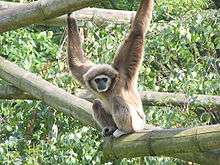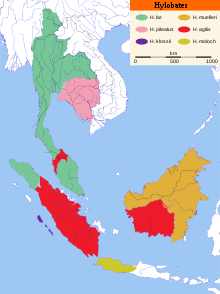Hylobates
The genus Hylobates /ˌhaɪloʊˈbeɪtiːz/ is one of the four genera of gibbons. Its name means "forest walker", from the Greek hūlē (ὕλη, "forest") and bates (βάτης, "one who treads").[3][4]
| Hylobates[1][2] | |
|---|---|
 | |
| Lar gibbon | |
| Scientific classification | |
| Kingdom: | Animalia |
| Phylum: | Chordata |
| Class: | Mammalia |
| Order: | Primates |
| Suborder: | Haplorhini |
| Infraorder: | Simiiformes |
| Family: | Hylobatidae |
| Genus: | Hylobates Illiger, 1811 |
| Type species | |
| Hylobates lar Linnaeus, 1771 | |
| Species | |
 | |
| Distribution of Hylobates and its species (note: Bornean population formerly included in H. agilis is now generally considered a separate species, H. albibarbis) | |
It was once considered the only genus, but recently its subgenera (Hoolock [formerly Bunopithecus], Nomascus, and Symphalangus) have been elevated to the genus level.[1][5] Hylobates remains the most speciose and widespread of gibbon genera, ranging from southern China (Yunnan) to western and central Java.
Individuals within this genus are characterized by 44 chromosomes and often have a ring of white fur around their faces.[2]
Classification
- Family Hylobatidae: gibbons[1][2]
- Genus Hylobates
- Lar gibbon or white-handed gibbon, Hylobates lar
- Malaysian lar gibbon, Hylobates lar lar
- Carpenter's lar gibbon, Hylobates lar carpenteri
- Central lar gibbon, Hylobates lar entelloides
- Sumatran lar gibbon, Hylobates lar vestitus
- Yunnan lar gibbon, Hylobates lar yunnanensis
- Bornean white-bearded gibbon, Hylobates albibarbis
- Agile gibbon or black-handed gibbon, Hylobates agilis
- Müller's gibbon, Hylobates muelleri
- Müller's gray gibbon, Hylobates muelleri muelleri
- Abbott's gray gibbon, Hylobates muelleri abbotti
- Northern gray gibbon, Hylobates muelleri funereus
- Silvery gibbon, Hylobates moloch
- Western silvery gibbon or western Javan gibbon, Hylobates moloch moloch
- Eastern silvery gibbon or central Javan gibbon, Hylobates moloch pongoalsoni
- Pileated gibbon or capped gibbon, Hylobates pileatus
- Kloss's gibbon or Mentawai gibbon or bilou, Hylobates klossii
- Lar gibbon or white-handed gibbon, Hylobates lar
- Genus Hoolock
- Genus Symphalangus
- Genus Nomascus
- Genus Hylobates
Hybrids
Hybrids between Müller's gibbon (Hylobates muelleri) and the Bornean white-bearded gibbon, (Hylobates albibarbis) have been reported in areas of Borneo.[6]
References
- Groves, C. P. (2005). "Genus Hylobates". In Wilson, D. E.; Reeder, D. M. (eds.). Mammal Species of the World: A Taxonomic and Geographic Reference (3rd ed.). Baltimore: Johns Hopkins University Press. pp. 178–181. ISBN 0-801-88221-4. OCLC 62265494.
- Geissmann, Thomas. "Gibbon Systematics and Species Identification". Retrieved 2006-04-13.
- βάτης. Liddell, Henry George; Scott, Robert; A Greek–English Lexicon at the Perseus Project: "one that treads or covers"
- Craig, John (1848). A new universal etymological technological, and pronouncing dictionary of the English language. p. 962.
- Mootnick, A.; Groves, C. P. (2005). "A new generic name for the hoolock gibbon (Hylobatidae)". International Journal of Primatology. 26 (26): 971–976. doi:10.1007/s10764-005-5332-4.
- Payne, J.; Francis, C. (2005). A Field Guide to the Mammals of Borneo. Kota Kinabalu, Sabah, Malaysia: Sabah Society. p. 230. ISBN 967-99947-1-6.
External links
| Wikispecies has information related to Hylobates |